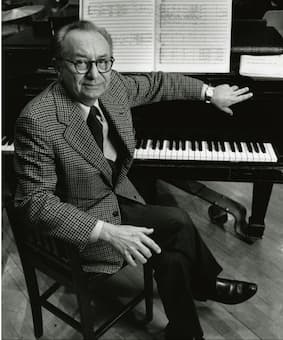
Vincent Persichetti (1981) (Photo by Peter Schaaf)
We really can’t think of two more contrasting composers than Mozart and Mussorgsky – the first is a composer for whom the melodies flowed like water and the second a man for whom music was difficult to bring to completion – but who was still able to create memorable music.
Vincent Persichetti (1915-1987) has become one of the forgotten masters. Although writers protest that he’s one of the great composers of 20th century America, you don’t see his works programmed anymore at the professional level.
His first job was at the Philadelphia Conservatory before being hired by The Juilliard School to teach composition – he held that post for 40 years, and students included composers we still know today such as Philip Glass and Steve Reich, Jacob Druckman and Richard Danielpour, and Laurie Spiegel and Elena Ruehr, as well as Peter Schickele (aka P.D.Q. Bach), who remembered him as ‘a terrific teacher — a prodigious musician with an awesome musical memory and great sightreading skills….’
Liking the alliteration, Persichetti referred to his own style as ‘graceful’ and ‘gritty’ – covering his graceful melodies and gritty rhythms nicely. He primarily wrote piano music and music for wind band, but he did write 9 symphonies, before withdrawing the first two. In 1951, he finished his Symphony No. 4.
He said that the work seemed to just flow from his pen – it takes from Mozart its tight structure and from Mussorgsky a kind of quirky brightness. The first movement moves between sharp and emphatic tuttis of the whole orchestra, and small string solos. The brass sound takes a lot from wind band music. It ends in a grand swoop up.
Vincent Persichetti: Symphony No. 4, Op. 51 – I. Adagio – Allegro (Philadelphia Orchestra, Eugene Ormandy, cond.)
The second movement, a slow Andante, seems more like an American wandering piece. It doesn’t have the melodies of either Mozart or Mussorgsky but seems more like something from Copland. One writer called the movement ‘gawky’and that awkwardness seems an integral part of its character.
Vincent Persichetti: Symphony No. 4, Op. 51 – II. Andante (Philadelphia Orchestra, Eugene Ormandy, cond.)
The Allegretto brings us back to a positive focus. The strings are muted, and the winds provide a brighter swirl of sound.
Vincent Persichetti: Symphony No. 4, Op. 51 – III. Allegretto (Philadelphia Orchestra, Eugene Ormandy, cond.)
The final movement Presto sweeps us up and carries us off until we get to the main subject in the strings. We start with a Bernstein like motion and then the main subject returns us to a more classical age. The emphatic use of brass and timpani propel the movement forward at speed.
Vincent Persichetti: Symphony No. 4, Op. 51 – IV. Presto (Philadelphia Orchestra, Eugene Ormandy, cond.)
The work was given its premiere by the Philadelphia Orchestra led by Eugene Ormandy. Persichetti’s report from the work on tour both domestically and internationally was succinct: ‘Philadelphia liked the work; Washington loved it. Amsterdam enjoyed it; and New York tolerated it. Baltimore scarcely heard it — and who can tell what the British think?’
As an important orchestral work from the 1950s, Persichetti’s fourth symphony deserves to be better known. Its amalgam of so many parts of classical orchestral music with pure 20th century sound hasn’t really been matched by other composers’ work.
For more of the best in classical music, sign up to our E-Newsletter



